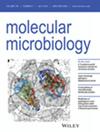ModE对产甲烷菌活性甲烷菌替代氮酶表达的调控。
IF 2.6
2区 生物学
Q3 BIOCHEMISTRY & MOLECULAR BIOLOGY
引用次数: 0
摘要
所有能固定氮的产甲烷菌都使用钼(Mo)固氮酶。一些产甲烷菌,包括活性产甲烷菌,也含有钒氮和铁氮的替代酶,分别由vnf和反f操纵子编码。当没有足够的Mo来支持Mo-氮酶的活性时,就会产生这些氮酶。在产甲烷菌中,控制替代氮酶表达以响应Mo有效性的因素尚不清楚。这里显示模式的监管机构压制vnf转录和曾帮工操纵子细胞生长在m . acetivorans莫。CRISPRi镇压模式导致显著增加转录vnf和曾帮工的操纵子的检测以及在密苏里州的固氮Fe-nitrogenase。凝胶转变分析与重组模式表明,模式结合特定序列图案上游vnf和曾帮工的操纵子,以及其他与固氮和钼运输有关的基因和操纵子。然而,纯化后的ModE不含Mo, Mo的加入也不会改变ModE对DNA的亲和力,这表明m.a actitivorans的ModE可能不会直接结合Mo。本研究表明,ModE是m.a actitivorans中替代氮酶表达的主要Mo响应调节因子,但其他因素可能参与了直接感知Mo。本文章由计算机程序翻译,如有差异,请以英文原文为准。
ModE Regulates Alternative Nitrogenase Expression in the Methanogen Methanosarcina acetivorans.
All methanogens that can fix nitrogen use molybdenum (Mo) nitrogenase. Some methanogens, including Methanosarcina acetivorans, also contain alternative vanadium- and iron-nitrogenases, encoded by the vnf and anf operons, respectively. These nitrogenases are produced when there is insufficient Mo to support Mo-nitrogenase activity. The factors that control the expression of the alternative nitrogenases in response to Mo availability are unknown in methanogens. Here we show that ModE is the regulator that represses transcription of the vnf and anf operons in M. acetivorans when cells are grown with Mo. CRISPRi repression of modE results in a significant increase in the transcription of the vnf and anf operons as well as the detection of Fe-nitrogenase during nitrogen fixation in the presence of Mo. Gel shift assays with recombinant ModE demonstrated that ModE binds a specific sequence motif upstream of the vnf and anf operons, as well as other genes and operons related to nitrogen fixation and Mo transport. However, purified ModE does not contain Mo, and the addition of Mo does not alter the affinity of ModE for DNA, indicating M. acetivorans ModE may not directly bind Mo. This study shows that ModE is the primary Mo-responsive regulator of alternative nitrogenase expression in M. acetivorans, but other factor(s) are likely involved in directly sensing Mo.
求助全文
通过发布文献求助,成功后即可免费获取论文全文。
去求助
来源期刊

Molecular Microbiology
生物-生化与分子生物学
CiteScore
7.20
自引率
5.60%
发文量
132
审稿时长
1.7 months
期刊介绍:
Molecular Microbiology, the leading primary journal in the microbial sciences, publishes molecular studies of Bacteria, Archaea, eukaryotic microorganisms, and their viruses.
Research papers should lead to a deeper understanding of the molecular principles underlying basic physiological processes or mechanisms. Appropriate topics include gene expression and regulation, pathogenicity and virulence, physiology and metabolism, synthesis of macromolecules (proteins, nucleic acids, lipids, polysaccharides, etc), cell biology and subcellular organization, membrane biogenesis and function, traffic and transport, cell-cell communication and signalling pathways, evolution and gene transfer. Articles focused on host responses (cellular or immunological) to pathogens or on microbial ecology should be directed to our sister journals Cellular Microbiology and Environmental Microbiology, respectively.
 求助内容:
求助内容: 应助结果提醒方式:
应助结果提醒方式:


